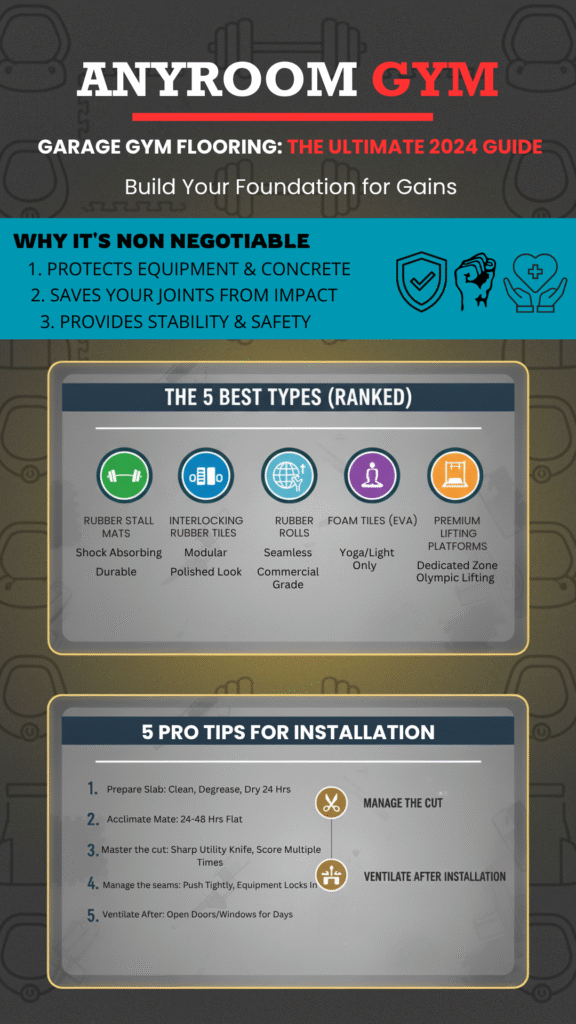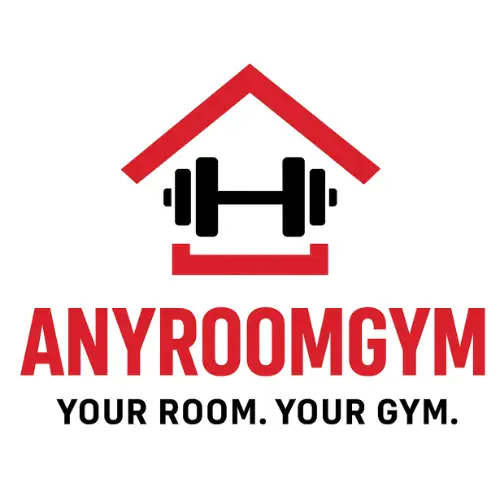Your garage gym is your sanctuary. It’s where goals are chased and PRs are broken. But every great sanctuary needs a solid foundation. Your garage gym flooring is that foundation. It is not just decoration. It is a critical piece of safety equipment.
The right floor protects your concrete slab. It saves your barbells and dumbbells from damage. Most importantly, it protects your joints from the hard, unyielding concrete. The wrong floor can lead to injury, broken equipment, and a cracked floor.
Choosing the perfect flooring can feel overwhelming. This guide cuts through the confusion. We break down the five best types of garage gym flooring. We provide a clear cost comparison. We give you five pro tips for a flawless installation. Let’s build your gym’s foundation the right way.
Why Garage Gym Flooring Is Non-Negotiable
Think of your garage floor as the platform for every single rep. Dropping a deadlift on bare concrete is a recipe for disaster. The shock can crack the concrete. It can destroy your expensive bumper plates. The vibration can damage your walls.
For you, the lifter, it’s worse. Training on hard concrete is brutal on your joints. Your knees, ankles, and back absorb every impact. Over time, this leads to unnecessary pain and fatigue.
The right garage gym flooring solves this. It absorbs shock. It dampens noise for your family and neighbors. It provides a stable, non slip surface for explosive lifts. It transforms a cold garage into a professional training space. This is not an optional upgrade. It is the first and most important purchase for your home gym flooring.
The 5 Best Types of Garage Gym Flooring (Ranked)
From the budget-friendly champion to the specialist’s choice, here are your best options.
Rubber Stall Mats
These are the undisputed kings of the home gym world. Originally designed as horse stall mats, their value for gym owners is unmatched. You’ll often find them at farm supply stores like Tractor Supply.
✓ Pros: Extremely durable and cost-effective. Excellent shock and noise absorption. Great non-slip surface.
✗ Cons: Very heavy (around 100 lbs per mat). Can have a initial rubber smell. Requires effort to cut for a perfect fit.
Best For: Nearly every home gym owner. The best value for heavy lifting.
Interlocking Rubber Tiles
These tiles offer a modular, puzzle-like design. They create a uniform and professional-looking floor. They are a popular choice for a clean home gym flooring setup.
✓ Pros: Easier to install than stall mats. No heavy lifting of large mats. Easy to replace a single damaged tile.
✗ Cons: More expensive per square foot. Seams can trap dirt and moisture.
Best For: DIY enthusiasts who want a polished look and easier installation.
Rubber Rolls
For a seamless, commercial-grade look, rubber flooring rolls are the top choice. They provide a continuous surface across your entire gym space.
✓ Pros: Completely seamless surface. Ideal for cleanliness and sled work. Ultra-professional appearance.
✗ Cons: Difficult and awkward to install. Often requires adhesive. Generally the most expensive rubber option.
Best For: Those seeking a pristine, commercial gym look and who may hire a professional installer.
Foam Tiles (EVA)
These lightweight, interlocking tiles are common in playrooms. They are soft and easy to handle. But they are not built for a serious gym.
✓ Pros: Very inexpensive and extremely easy to cut and install. Soft underfoot.
✗ Cons: Not durable. They compress and tear under heavy weights or power racks. Entirely unsuitable for dropped weights.
Best For: Yoga, bodyweight exercises, or a child’s play area. Not for weight training.
Premium Lifting Platforms
This is a custom built solution. A lifting platform combines plywood and a rubber top layer. It is engineered for one purpose: absorbing the massive force of a dropped barbell.
✓ Pros: The ultimate surface for Olympic weightlifting. Defines a dedicated training zone. Exceptional protection.
✗ Cons: Expensive and a permanent fixture. Takes up significant space. Overkill for general fitness.
Best For: Olympic weightlifters and CrossFit athletes who regularly drop weights from overhead.
Garage Gym Flooring Cost & Comparison Table
This table gives you a quick, data-driven snapshot to help you decide.
| Flooring Type | Cost (per sq. ft.) | Durability | Shock Absorption | Installation | Best For |
|---|---|---|---|---|---|
| Rubber Stall Mats | $1.50 – $2.50 | Excellent | Excellent | Moderate | Heavy lifting, best value |
| Interlocking Tiles | $2.50 – $4.00 | Excellent | Excellent | Easy | DIY, finished look |
| Rubber Rolls | $3.50 – $6.00+ | Excellent | Excellent | Hard | Seamless, commercial look |
| Foam Tiles (EVA) | $0.50 – $1.50 | Poor | Good (but compresses) | Very Easy | Yoga, light exercise only |
| Lifting Platform | $200+ (for 8’x8′) | Exceptional | Exceptional | Hard | Olympic Weightlifting |
5 Pro Tips for Installing Your Garage Gym Floor
A perfect install ensures your floor lasts for decades. Follow these steps.
- Prepare Your Concrete Slab. This is the most critical step. Sweep the floor thoroughly. Use a degreaser on any oil stains. Mop the entire area and let it dry completely for at least 24 hours. Trapped moisture leads to mold and mildew under your mats.
- Let the Mats Acclimate. Unroll your rubber gym flooring and let it sit flat in your garage for 24-48 hours before you install it. This allows the material to relax and lose its “roll memory.” It also helps off-gas any initial smell.
- Master the Cut. For stall mats, use a sharp utility knife and a sturdy straight edge. Score the mat deeply several times don’t try to cut through in one go. Be patient. Wear a mask to avoid breathing in rubber dust.
- Manage the Seams. Push interlocking tiles together tightly until you hear a solid “click.” For stall mats, shove them against each other with force. Don’t worry about small gaps. The immense weight of your power rack and equipment will lock everything in place.
- Ventilate After Installation. Once your floor is down, keep the garage ventilated for a few days. Open the door and windows. This will quickly dissipate any lingering rubber odor, leaving your gym fresh and ready for action.

Function vs. Aesthetics: Which Is Right for You?
Your choice depends on your primary goal.
- Pure Function: If your only concerns are protection, performance, and budget, the answer is simple. Horse stall mats are the undisputed champion. They are the gold standard for a reason.
- Function & Form: If you want a sleek, modern look and are willing to pay more for it, choose interlocking rubber tiles or a professionally installed rubber roll. This elevates the entire space aesthetically.
- The Hybrid Approach: Many experienced gym owners combine the best of both worlds. They use stall mats for 90% of the floor and build a custom lifting platform in the rack. This is the ultimate setup for the serious lifter.
“Strength does not come from winning. Your struggles develop your strengths.” – Arnold Schwarzenegger
Conclusion: Build a Strong Foundation for Your Gains
Your garage gym flooring is the stage for your transformation. It is the unsung hero of every personal record and every drop of sweat. Investing in a high-quality floor is an investment in your safety, your equipment, and your long-term progress.
By choosing durable rubber floor mats, you are building a foundation that will last. You are creating a space where you can train with confidence and purpose. Now, the hard work begins. Now, you can focus on what truly matters: lifting, grinding, and becoming stronger.
With your foundation secure, the next step is to build upward. Continue creating your perfect training space with our complete home gym setup guide.
Ready to equip the rest of your gym? Explore our in-depth reviews on power racks, barbells, and benches to finish building your ultimate strength training sanctuary Your Fitness Road Map
